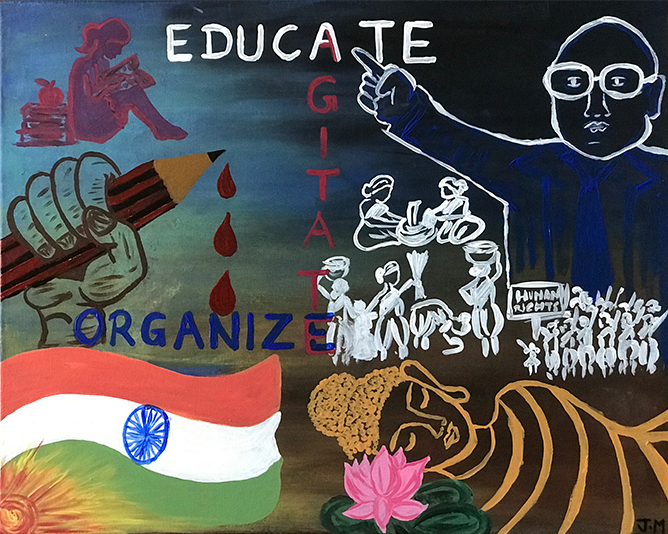
Recently Birsa Ambedkar Phule Students’ Association (BAPSA), a student organization in Jawaharlal Nehru University (JNU) based upon Ambedkar’s ideas and thought marked their first victory in the Jawaharlal Nehru University Students’ Union (JNUSU) elections for the central panel. Priyanshi Arya, the elected candidate for the post of General Secretary of the JNUSU from BAPSA, pointed out the solidarities by the savarna allies of the Ambedkarite movement after the win.
“Our upper caste allies are also associated with our Ambedkarite movement, but we do not want them to tell us how Dalits are oppressed. Instead, they should tell us how Brahminism operates in their homes and their families. They should contribute to us not by teaching about our struggle, but by understanding. What is your stand” – Priyanshi Arya (BAPSA, General Secretary of JNUSU)
They even pointed out the beliefs that BAPSA won due to the support of the left, however, they pointed out that it was JNU students who supported BAPSA. However, BAPSA’s rise in JNU and these statements by Priyanshi expose the Savarna solidarities within the Ambedkarite Movement. Based upon Angus Dawson’s (2012) conceptualization of solidarities, I would classify these solidarities in the Ambedkarite struggle or Movement into three types. First, standing up as Dalits. Second, standing for Dalits. Third, standing with Dalits.
Standing up as Dalits is the one when savarnas share the experiences of Dalits. This is what I think Priyanshi pointed out when they warned that Savarna allies should not tell us how Dalits are oppressed. Savarnas working on the issues of caste often commit this mistake of representing the Dalit voices. However, it lacks credibility and a phenomenological understanding of the challenges of being a Dalit. It raises ontological questions about Savarnas. Moreover, for Dalit-Bahujans it is very easy to point out the difference between the perspective from above by the savarnas and the perspectives from below about caste oppression. However, Savarnas may be genuine in their concern when they want to experience the reality of Dalits. Therefore, they might attempt to speak as Dalit. However, it is neither desired by the Dalits that someone should be like Dalits or they should face caste oppression like them. Nor do Dalits need pseudo voices to articulate Dalit experiences. If Savarnas want to assist, they can talk about the perpetuation of caste in and from their households. It will be an excellent opportunity where one can talk about Brahmanism, and how caste operates in the savarna world.
The second type of solidarity is Standing for Dalits. This comes with an intention to assist or educate Dalits. It comes with the presumption and prenotion that Dalits need savarnas to represent and advocate for them. Savarnas think that Dalits and Bahujans cannot speak for themselves therefore we should take the mike from them and speak on their own. A Dalit’s silence on the mic communicates more reality of our world than long speeches by Savarnas, about the Ambedkarite struggle against caste oppression. They talk about issues of marginalization, inequality and discrimination among Dalits who are oppressed and victims of the social structures. My question to them is, who needs to hear what we already know? For us, it’s lived reality. They tend to do it as charity, but charity begins at home. Who are you to stand up for us? Do we need charity? If you want to do charity, start with your household. If you are here to reform, then start with your family. If you want to bring revolution, bring it to your community. Shouldn’t they preach lessons upon equality among their kins who commit atrocities on Dalits and Bahujans? Why don’t they speak about the caste privileges of their communities? They tend to appropriate Ambedkar and raise slogans like ‘Jai Bhim’ for Bahujan support but fail to reject Brahmanical patriarchy. How can one speak for Dalits without leaving one’s caste identity markers and privileges?
Savarna allies in their struggles tend to use Ambedkarite platforms to brand themselves. It’s a support possibly due to underlying self-interest of influence and popularity. Instead, they can help in empowerment so that we can speak for ourselves. Instead of getting on stages why don’t you build more stages where Dalits could hold mics and represent themselves? We do not need sympathy. Now the question comes how can savarnas contribute to the Ambedkarite movement?
The answer to the above question brings me to the last, and third kind of solidarity which is empathy or Standing with Dalits. This is the kind of solidarity which oppressed groups desire. It’s a stronger type of fellowship and mutual recognition than standing up for Dalits. It’s not about being in a charitable position or located hierarchy in the movements but along with us, being supportive instead of substituting or eating our opportunities of leadership. It acknowledges the challenges and oppression of being Dalit. It recognizes the capacity, autonomy, and agency of Dalits and involves entry into the life world of Dalits. It’s about the equality among us. As a savarna one can stand with us but not as a Dalit!
Reference:
Dawson, A., & Verweij, M. (2012). Solidarity: A Moral Concept in Need of Clarification. Public Health Ethics, 5(1): 1-5.
***
Jatin Mathur is enrolled in a Master’s in Sociology at the Delhi School of Economics (DSE).
Nice article